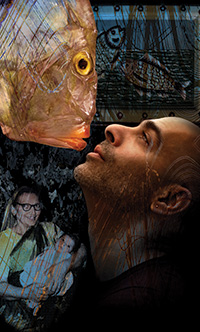Categorising and pitching interdisciplinary work is not easy, but can be hugely productive, says Tim Jones

In ‘Great Art for Everyone’, Arts Council England (ACE) Chair Dame Liz Forgan writes that “artforms are morphing and combining... it is getting harder and harder to be sure where the boundaries are”. Few would dispute that we’ve entered an age in which artists draw on ever-expanding toolsets to create works that aren’t just falling between artform categories – they’re beginning to raise questions about the limitations of categories. Consider Bristol’s Pervasive Media Studio, championing a wave of experimental performance makers who use technology to take audiences beyond auditoria. Or Requardt and Rosenberg’s ‘Electric Hotel’, produced by Fuel, which exists somewhere between dance, site-specific event and audio installation. Morphing and synthesising, it seems, are everywhere.
How, though, can we best support these works to engage with large audiences? Given that, realistically, much of the public still prefers to know what it’s getting before it gets it, and might be skittish when offered the hard-to-categorise? For a long period, ‘interdisciplinary’ didn’t do itself many favours. In the past, the label has been applied automatically and complacently to collaborations across disciplines – typically in the context of artist-led research and development (R&D) within academia – as if working across or between artforms somehow generated greater intrinsic value than work that’s happily progressing within a single artform. Without a means to clarify and share its value, interdisciplinary R&D sailed dangerously close to indulgence until a few years ago.
THINGS ARE CHANGING
In 2006, Hannah Redler of the Science Museum pointed out that ‘digital/media arts’ might shortly disappear as a category, as greater numbers of art school graduates, who will have naturally included the affordances of digital within their training, begin to establish careers. She may be right: the barriers to digital are now low enough for a critical mass of artists of all kinds to consider how it might transform their artistic offers. And we are all adapting to the open, sharing culture of web 2.0, which can involve the public in the process of iteratively developing a prototype. This approach, which typically results in more robust ideas and a much clearer sense of what excites the public about an idea, makes the research-driven interdisciplinary work of just a few years ago feel, by comparison, precious and unsure of its ability to find its way to general audiences.
What I find most exciting right now is the possibility of collaboration across sectors – not only artistic disciplines but wholly different fields. This is particularly timely in the current climate, when cultural organisations should be ‘turning their wagons outwards’ if they’re to endure. When I met Lady Genista McIntosh, I asked her to imagine a world in which every arts manager had a bright red phone on their desk, all of which she could ring simultaneously, though she could only say one sentence before the line went dead. What would she say? She didn’t hesitate: “Get viral!”
JARGON BUSTERS
There’s still a significant jargon issue to be addressed, and a nervous engagement persists among traditional arts funders. Though there are clear champions – the Jerwood Charitable Foundation, and the Wellcome Trust – interdisciplinary work has had a patchy record of funder support, and it would be great if the arts councils were to open channels to funding bodies of a kind that might not support the arts directly, but with whom there might be other connections. In the meantime, a new generation of producers are picking up the slack: applying their entrepreneurial talents to translate and to broker, and to get the work to the public. Building on the great work of ACE and the Jerwood Foundation of a few years ago, which achieved recognition of the crucial role of producers within the arts ecology, I’m among a group who are picking up the baton and exploring how they might undergo more effective professional development. I’ve been concerned to keep as open as possible the community of producers this project might serve – to find ways to be relevant not just across or between disciplines, but also across career positions, locations and economies. Interdisciplinary thinking implies cross-pollination, and so strength through diversity.
Motiroti is a company steeped in experience of working across platforms – its project ‘Alladeen’ existed as a stage performance, an installation, an online interactive and a music video. Its drive to work across disciplines is far from introspective: the company is trying to reach large audiences, and recognises that, while we each have our own artform preferences, great art can touch us all: so we need to go to the different places where people are to engage them. Our current portfolio explores culture and migration through food, and will, I hope, take us through some or all of theatres, museums, exhibition halls, publications and online as we find exciting ways to reach the public.
Tim Jones is is Executive Director of international arts organisation motiroti. He is currently conducting a survey of creative producers: bit.ly/a1bxTh
This week Tim was blown away by Julius Popp’s
‘bit.fall’ water installation running at Canary Wharf, and got his one-and-a-half-year-old daughter onto the ‘arts engagement’ map by taking her to see ‘Tell Tale Hearts’ at Jackson's Lane.



